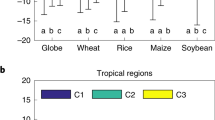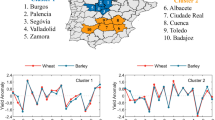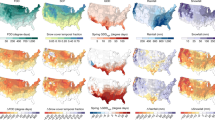Abstract
An important source of uncertainty in anticipating the effects of climate change on agriculture is limited understanding of crop responses to extremely high temperatures1,2. This uncertainty partly reflects the relative lack of observations of crop behaviour in farmers’ fields under extreme heat. We used nine years of satellite measurements of wheat growth in northern India to monitor rates of wheat senescence following exposure to temperatures greater than 34 °C. We detect a statistically significant acceleration of senescence from extreme heat, above and beyond the effects of increased average temperatures. Simulations with two commonly used process-based crop models indicate that existing models underestimate the effects of heat on senescence. As the onset of senescence is an important limit to grain filling, and therefore grain yields, crop models probably underestimate yield losses for +2 °C by as much as 50% for some sowing dates. These results imply that warming presents an even greater challenge to wheat than implied by previous modelling studies, and that the effectiveness of adaptations will depend on how well they reduce crop sensitivity to very hot days.
This is a preview of subscription content, access via your institution
Access options
Subscribe to this journal
Receive 12 print issues and online access
$209.00 per year
only $17.42 per issue
Buy this article
- Purchase on Springer Link
- Instant access to full article PDF
Prices may be subject to local taxes which are calculated during checkout



Similar content being viewed by others
References
Wardlaw, I. & Wrigley, C. Heat tolerance in temperate cereals: An overview. Aust. J. Plant Physiol. 21, 695–703 (1994).
Asseng, S., Foster, I. & Turner, N. C. The impact of temperature variability on wheat yields. Glob. Change Biol. 17, 997–1012 (2011).
Ritchie, J. T. & NeSmith, D. S. in Modeling Plant and Soil Systems Vol. 31 (eds Hanks, J. & Ritchie, J. T.) 5–29 (American Society of Agronomy, 1991).
Tashiro, T. & Wardlaw, I. F. A comparison of the effect of high temperature on grain development in wheat and rice. Ann. Bot. 64, 59–65 (1989).
Wardlaw, I. & Moncur, L. The response of wheat to high temperature following anthesis. I. The rate and duration of kernel filling. Funct. Plant Biol. 22, 391–397 (1995).
Sofield, I., Evans, L., Cook, M. & Wardlaw, I. Factors influencing the rate and duration of grain filling in wheat. Funct. Plant Biol. 4, 785–797 (1977).
Zhao, H., Dai, T., Jing, Q., Jiang, D. & Cao, W. Leaf senescence and grain filling affected by post-anthesis high temperatures in two different wheat cultivars. Plant Growth Regul. 51, 149–158 (2007).
Harding, S. A., Guikema, J. A. & Paulsen, G. M. Photosynthetic decline from high temperature stress during maturation of wheat: I. Interaction with senescence processes. Plant Physiol. 92, 648–653 (1990).
Reynolds, M. P., Balota, M., Delgado, M. I. B., Amani, I. & Fischer, R. A. Physiological and morphological traits associated with spring wheat yield under hot, irrigated conditions. Aust. J. Plant Physiol. 21, 717–730 (1994).
Al-Khatib, K. & Paulsen, G. M. Mode of high temperature injury to wheat during grain development. Physiol. Plant. 61, 363–368 (1984).
Al-Khatib, K. & Paulsen, G. M. High-temperature effects on photosynthetic processes in temperate and tropical cereals. Crop Sci. 39, 119–125 (1999).
Gupta, R. et al. Wheat productivity in indo-gangetic plains of India during 2010: Terminal heat effects and mitigation strategies. PACA Newsletter 14, 1–11 (2010).
Wilkens, P. & Singh, U. in Modeling Temperature Response in Wheat and Maize (ed. White, J. W.) 1–7 (CIMMYT, 2001).
Stone, P. & Nicolas, M. Wheat cultivars vary widely in their responses of grain yield and quality to short periods of post-anthesis heat stress. Funct. Plant Biol. 21, 887–900 (1994).
Ferris, R., Ellis, R., Wheeler, T. & Hadley, P. Effect of high temperature stress at anthesis on grain yield and biomass of field-grown crops of wheat. Ann. Bot. 82, 631–639 (1998).
Zwiers, F. W., Zhang, X. & Feng, Y. Anthropogenic influence on long return period daily temperature extremes at regional scales. J. Clim. 24, 881–892 (2011).
Meehl, G. A. et al. in IPCC Climate Change 2007: The Physical Science Basis (eds Solomon, S. et al.) (Cambridge Univ. Press, 2007).
Betts, R. A. et al. When could global warming reach 4 °C? Phil. Tran. R. Soc. A 369, 67–84 (2011).
Food and Agriculture Organization of the United Nations. Fertilizer Use by Crop in India (FAO, 2005).
Randhawa, A., Dhillon, S. & Singh, D. Productivity of wheat varieties as influenced by the time of sowing. J. Res. Punjab Agr. Univ. 18, 227–233 (1981).
Aggarwal, P. K. & Kalra, N. Analyzing the limitations set by climatic factors, genotype, and water and nitrogen availability on productivity of wheat. 2. Climatically potential yields and management strategies. Field Crop. Res. 38, 93–103 (1994).
Chandna, P. et al. Increasing the Productivity of Underutilized Lands by Targeting Resource Conserving Technologies-A GIS/Remote Sensing Approach: A Case Study of Ballia District, Uttar Pradesh, in the Eastern Gangetic Plains 43 (CIMMYT, 2004).
Fujisaka, S., Harrington, L. & Hobbs, P. Rice-wheat in South Asia: Systems and long-term priorities established through diagnostic research. Agr. Syst. 46, 169–187 (1994).
Ortiz-Monasterio, J. I., Dhillon, S. S. & Fischer, R. A. Date of sowing effects on grain-yield and yield components of irrigated spring wheat cultivars and relationships with radiation and temperature in Ludhiana, India. Field Crop. Res. 37, 169–184 (1994).
van Oort, P. A. J., Zhang, T., de Vries, M. E., Heinemann, A. B. & Meinke, H. Correlation between temperature and phenology prediction error in rice (Oryza sativa L.). Agr. Forest Meteorol. 151, 1545–1555 (2011).
Monfreda, C., Ramankutty, N. & Foley, J. A. Farming the planet: 2. Geographic distribution of crop areas, yields, physiological types, and net primary production in the year 2000. Glob. Biogeochem. Cycles 22, GB1022 (2008).
Mitchell, T. D. & Jones, P. D. An improved method of constructing a database of monthly climate observations and associated high-resolution grids. Int. J. Climatol. 25, 693–712 (2005).
Hsiang, S. M. Temperatures and cyclones strongly associated with economic production in the Caribbean and Central America. Proc. Natl Acad. Sci. USA 107, 15367–15372 (2010).
Lobell, D. B. et al. Analysis of wheat yield and climatic trends in Mexico. Field Crop. Res. 94, 250–256 (2005).
Acknowledgements
We thank the APSIM team for providing their model and S. Hsiang for providing the code to estimate heteroskedasticity- and autocorrelation-consistent standard errors. This work was supported by the Rockefeller Foundation and NASA New Investigator grant no. NNX08AV25G to D.B.L.
Author information
Authors and Affiliations
Contributions
D.B.L. conceived the study, D.B.L. and A.S. analysed data, A.S. carried out crop model simulations, and D.B.L., A.S. and J.I.O-M. interpreted results and wrote the paper.
Corresponding author
Ethics declarations
Competing interests
The authors declare no competing financial interests.
Supplementary information
Rights and permissions
About this article
Cite this article
Lobell, D., Sibley, A. & Ivan Ortiz-Monasterio, J. Extreme heat effects on wheat senescence in India. Nature Clim Change 2, 186–189 (2012). https://doi.org/10.1038/nclimate1356
Received:
Accepted:
Published:
Issue Date:
DOI: https://doi.org/10.1038/nclimate1356
This article is cited by
-
Exploring the genotype-environment interaction of bread wheat in ambient and high-temperature planting conditions: a rigorous investigation
Scientific Reports (2024)
-
Inferring the impacts of climate extreme in the Kabul River Basin
Regional Environmental Change (2024)
-
The impact of climate change on wheat in Turkey
Regional Environmental Change (2024)
-
Identifying links between monsoon variability and rice production in India through machine learning
Scientific Reports (2023)
-
Extreme rainfall reduces one-twelfth of China’s rice yield over the last two decades
Nature Food (2023)



